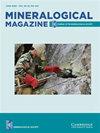印度西北部拉贾斯坦邦Newania碳酸岩杂岩的岩浆和岩浆后演化
IF 1.4
3区 地球科学
Q2 MINERALOGY
引用次数: 0
摘要
本文章由计算机程序翻译,如有差异,请以英文原文为准。
Magmatic and post-magmatic evolution of the Newania carbonatite complex, Rajasthan, north-western India
Abstract This work describes the mineralogy of dolomite carbonatite occurring at the Newania carbonatite complex, Rajasthan, north-western India. The mineralogy records the textural and compositional features of magmatic and post-magmatic stages of carbonatite evolution. Ferroan dolomite is the principal constituent and displays variable degrees of deformation, ranging from brittle-to-ductile deformation regimes. Apatite exhibits textural and compositional evolutionary trends from early-to-late stages of carbonatite evolution. Two varieties of amphibole are reported for the first time from this complex, ferri-winchite and cummingtonite; the former is magmatic and the latter is metamorphic in origin. The columbite–tantalite-series minerals are columbite-(Fe), and their paragenesis evolves from composite grains with pyrochlore to individual crystals. Pyrochlore is magmatic with U–Ta–Ti-rich compositions and shows evolution from calciopyrochlore to kenopyrochlore, followed by alteration during late-stages of carbonatite evolution. Monazite and baryte constitute the post-magmatic mineral assemblage; the former is hydrothermal and crystallised after precursor apatite, whereas the latter is associated exclusively with columbite–pyrochlore composites. On the basis of the mineralogy of the carbonatite, it is concluded that the parent magma was generated by low-degree partial melting of magnesite–phlogopite-bearing peridotite.
求助全文
通过发布文献求助,成功后即可免费获取论文全文。
去求助
来源期刊

Mineralogical Magazine
地学-矿物学
CiteScore
4.00
自引率
25.90%
发文量
104
审稿时长
6-12 weeks
期刊介绍:
Mineralogical Magazine is an international journal of mineral sciences which covers the fields of mineralogy, crystallography, geochemistry, petrology, environmental geology and economic geology. The journal has been published continuously since the founding of the Mineralogical Society of Great Britain and Ireland in 1876 and is a leading journal in its field.
 求助内容:
求助内容: 应助结果提醒方式:
应助结果提醒方式:


